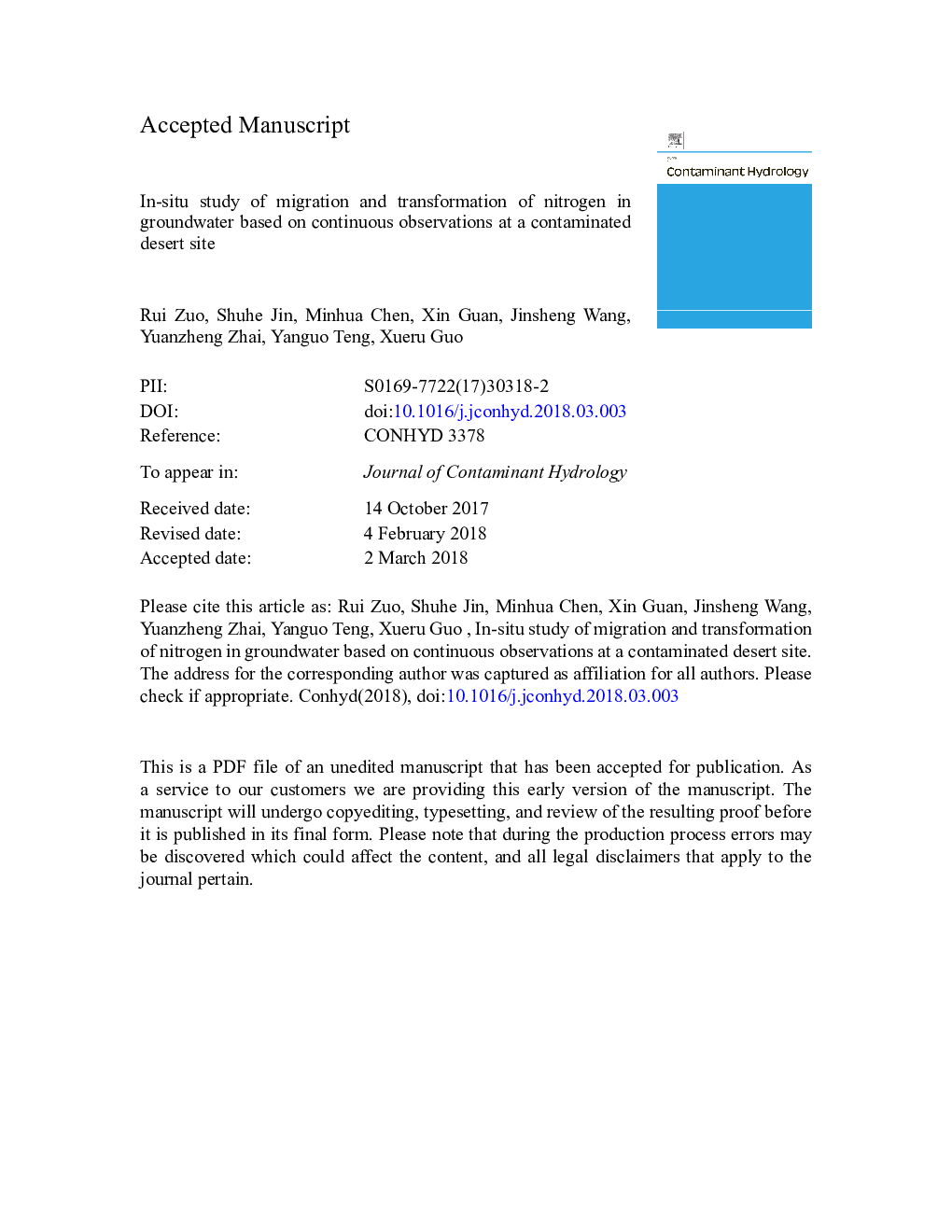| کد مقاله | کد نشریه | سال انتشار | مقاله انگلیسی | نسخه تمام متن |
|---|---|---|---|---|
| 8885825 | 1627000 | 2018 | 26 صفحه PDF | دانلود رایگان |
عنوان انگلیسی مقاله ISI
In-situ study of migration and transformation of nitrogen in groundwater based on continuous observations at a contaminated desert site
ترجمه فارسی عنوان
مطالعه در محل مهاجرت و تبدیل نیتروژن در آبهای زیرزمینی بر اساس مشاهدات پیوسته در یک محل بیابانی
دانلود مقاله + سفارش ترجمه
دانلود مقاله ISI انگلیسی
رایگان برای ایرانیان
کلمات کلیدی
مشاهدات در محل، مهاجرت، دگرگونی، نیتروژن، آب های زیرزمینی، سایت آلوده،
ترجمه چکیده
هدف از این مطالعه بررسی عوامل مؤثر بر انتقال و تبدیل زباله های نیتروژنی در آبهای زیرزمینی با استفاده از مشاهدات طولانی مدت از یک سایت آلوده در لبه جنوب غربی کویر تنگگر در شمال غربی چین است. آلودگی ناشی از تخلیه فاضلاب غنی از آمونیاک بود. دو چاه های نظارت بلند مدت آب های زیرزمینی (ولز 1 و شماره 2) ساخته شد و 24 نمونه آب جمع آوری شد. پنج شاخص کلیدی مورد آزمایش قرار گرفت: آمونیاک، نیترات، نیتریت، اکسیژن محلول و منگنز. یک روش عددی برای شبیه سازی فرایند مهاجرت و تعیین مرحله مهاجرت آلودگی اصلی آلودگی در آب های زیرزمینی استفاده شده است. نتایج نشان داد که در مرحله خلوص 1 # روند مهاجرت زباله های نیتروژنی اساسا تکمیل شد، درحالیکه در سطوح آمونیاک خالص 2 # هنوز افزایش یافت و به تدریج به یک مرحله پایدار منتقل شد. تفاوت های خالص 1 # و خلوص 2 # عمدتا ناشی از تفاوت در جریان آب های زیرزمینی بود. تغییر در غلظت آمونیاک عمدتا توسط مهاجرت آلودگی به نیتروفاسکی در آب های زیرزمینی کنترل می شود. میزان نیتریفیکاسیون احتمالا تحت تاثیر تغییرات اکسیژن محلول و منگنز بالقوه قرار گرفت.
موضوعات مرتبط
مهندسی و علوم پایه
علوم زمین و سیارات
فرآیندهای سطح زمین
چکیده انگلیسی
The objective of this study was to explore the controlling factors on the migration and transformation of nitrogenous wastes in groundwater using long-term observations from a contaminated site on the southwestern edge of the Tengger Desert in northwestern China. Contamination was caused by wastewater discharge rich in ammonia. Two long-term groundwater monitoring wells (Wells 1# and 2#) were constructed, and 24 water samples were collected. Five key indicators were tested: ammonia, nitrate, nitrite, dissolved oxygen, and manganese. A numerical method was used to simulate the migration process and to determine the migration stage of the main pollutant plume in groundwater. The results showed that at Well 1# the nitrogenous waste migration process had essentially been completed, while at Well 2# ammonia levels were still rising and gradually transitioning to a stable stage. The differences for Well 1# and Well 2# were primarily caused by differences in groundwater flow. The change in ammonia concentration was mainly controlled by the migration of the pollution plume under nitrification in groundwater. The nitrification rate was likely affected by changes in dissolved oxygen and potentially manganese.
ناشر
Database: Elsevier - ScienceDirect (ساینس دایرکت)
Journal: Journal of Contaminant Hydrology - Volume 211, April 2018, Pages 39-48
Journal: Journal of Contaminant Hydrology - Volume 211, April 2018, Pages 39-48
نویسندگان
Rui Zuo, Shuhe Jin, Minhua Chen, Xin Guan, Jinsheng Wang, Yuanzheng Zhai, Yanguo Teng, Xueru Guo,
